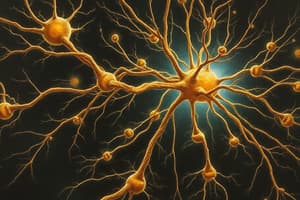Podcast
Questions and Answers
Which part of the nervous system controls involuntary functions such as heart rate, digestion, and breathing?
Which part of the nervous system controls involuntary functions such as heart rate, digestion, and breathing?
- Autonomic nervous system (correct)
- Peripheral nervous system
- Somatic nervous system
- Central nervous system
What are the four lobes of the brain and their specific functions?
What are the four lobes of the brain and their specific functions?
- Frontal, parietal, temporal, occipital - all responsible for movement
- Frontal - decision-making and movement, parietal - sensory processing, temporal - auditory information, occipital - visual information (correct)
- Frontal - thinking and planning, parietal - sensory processing, temporal - visual information, occipital - language
- Frontal - memory, parietal - sensory processing, temporal - language, occipital - visual information
What are Brudzinski's and Kernig's signs?
What are Brudzinski's and Kernig's signs?
- Symptoms of meningitis
- Tests for meningeal irritation and back pain, respectively (correct)
- Signs of autonomic nervous system dysfunction
- Types of traumatic hematomas
Flashcards are hidden until you start studying
Study Notes
Neurological Structure and Function: Key Concepts and Medical Conditions
- The brain controls and coordinates all body functions, interprets sensory information, and initiates responses, while the spinal cord serves as a pathway for nerve impulses traveling to and from the brain and integrates reflexes.
- Neurons are specialized cells that transmit nerve impulses, and neurotransmitters are chemical messengers that transmit signals between neurons or from neurons to muscles or glands.
- The central nervous system (CNS) consists of the brain and spinal cord and is responsible for processing and coordinating information, while the peripheral nervous system (PNS) comprises all nervous tissue outside the CNS, including sensory and motor neurons.
- The autonomic nervous system (ANS) controls involuntary functions such as heart rate, digestion, and breathing.
- The brain is divided into four lobes: the frontal, parietal, temporal, and occipital lobes, each with specific functions related to thinking, planning, decision-making, movement, sensory processing, auditory and visual information, memory, and language.
- The brainstem connects the brain to the spinal cord and controls vital functions such as breathing, heart rate, and blood pressure.
- Structures that protect the brain include the skull, three protective layers of tissue that surround the brain and spinal cord (dura, arachnoid, and pia), cerebrospinal fluid (CSF), and the blood-brain barrier.
- Stimulation of the parasympathetic nervous system can result in bradycardia, bronchoconstriction, constricted pupils, and bladder contraction, while stimulation of the sympathetic nervous system can lead to tachycardia, hyperglycemia, dilated pupils, bronchodilation, and sweating.
- Brain tumors can cause headache, vomiting, and papilla (head of the optic nerve) edema, and may require treatment with radiotherapy, chemotherapy, or surgical procedures such as burr hole, craniotomy, craniectomy, or cranioplasty.
- Meningitis can result in Brudzinski's and Kernig's signs, which are tests for meningeal irritation and back pain, respectively.
- CSF fistulas can occur from the nose (RINORE) or ear (OTORE) and require different management approaches, including avoiding nasal aspiration, applying pressure dressing, and keeping the mouth open while coughing to prevent increased intracranial pressure.
- Traumatic hematomas, such as epidural and subdural hematomas, are bleeding between different layers of tissue surrounding the brain and require careful monitoring of neurological status and positioning to avoid increased intracranial pressure.
Studying That Suits You
Use AI to generate personalized quizzes and flashcards to suit your learning preferences.




